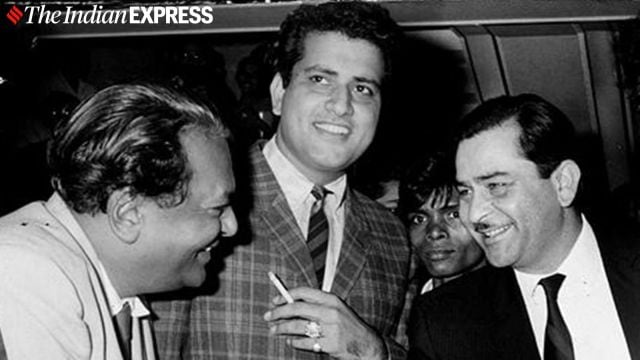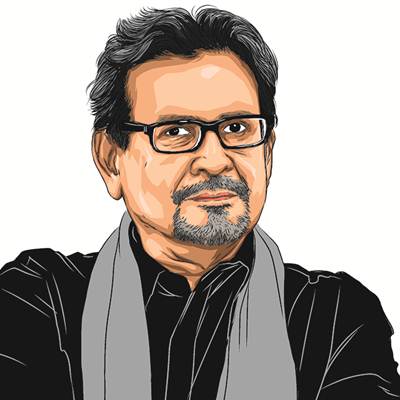Opinion Manoj Kumar, the man who made a ‘16,000-foot-long celluloid flag of India’
Kumar’s nationalistic zeal came forward at a time when India had undergone the trauma of fighting a war with China in 1962, and with Pakistan in 1965 and in 1971
 Harikrishan Giri Goswami, who would be known as Manoj Kumar in the Hindi film world, was known for his versatility and donned many creative caps. (Source: Express archive photo)
Harikrishan Giri Goswami, who would be known as Manoj Kumar in the Hindi film world, was known for his versatility and donned many creative caps. (Source: Express archive photo) It might sound strange but the violin strains of the lilting song “Ek pyaar ka nagma hai” in Manoj Kumar’s 1972 film Shor resonates in my mind with the violin strains of the film Mohabbatein (2000), the flow of memory connecting to the quiet flow of time. I remember watching the first show of Shor in Mumbai’s Opera House. The film was a departure from Kumar’s staple of nationalist melodramas. Apparently an anti-noise pollution film, Shor begins with the signature tune of the All India Radio/Vividh Bharati. Kumar, who starred in the film with Jaya Bhaduri (Bachchan) and Nanda, used the melody to establish morning, showing how the city becomes unbearably noisy right from the time it wakes up. Shot by veteran cinematographer Nariman Irani, Shor (including the songs) has some exquisite indoors and outdoors scenes, some underlit.
The initial quick montage shots hark back to Charlie Chaplin’s Modern Times (like how a shot of a flock of sheep cuts to crowds of factory workers). The film has another montage-within-a-shot — a funeral procession with the chant “Ram Naam Satya Hai” cutting across a wedding band blaring filmi songs, the decked-up groom on a horse, lifting the veil and looking at the dead body. This kind of juxtaposition of shots went on to become part of the general aesthetics of Manoj Kumar’s films, suitable for the rhetoric of patriotism (Upkaar, 1967), for creating visual escapes and eulogise the East over the West (Purab Aur Paschim, 1970), etc. Prior to Shor, Manoj Kumar had acted in Raj Kapoor’s Mera Naam Joker and had, perhaps, carried with him its surface empathy for the poor and the oppressed. Manoj Kumar had mastered the art of contrapuntal juxtapositions to attract audiences at sensuous level and simultaneously to provoke them patriotically. He also understood the power of water and used the rains to titillate, such as in the scene depicting a workers’ strike and the song “Paani re paani tera rang kaisa” in Shor.
Harikrishan Giri Goswami, who would be known as Manoj Kumar in the Hindi film world, was known for his versatility and donned many creative caps. He was born exactly a decade before India’s independence, in 1937 in Abbottabad, in what is today Pakistan’s North-West Frontier Province.
Kumar debuted as an actor in 1957. One of his notable performances was in the suspense thriller, Woh Kaun Thi (1964), directed by Raj Khosla. This black and white film tells the story of a young doctor played by Manoj Kumar who is obsessed with a woman, played by Sadhana. She appears to him with different names and in different guises, making him doubt his own sanity. A Hitchcockian film, Woh Kaun Thi had restrained acting, highlighting Manoj Kumar’s histrionic ability.
Kumar made his directorial debut with Upkaar (1967). He described the film as the “16,000-foot-long celluloid flag of India”. Kumar’s nationalistic zeal, verging on chauvinism as per some critics, had inaugurated itself at a time when India had undergone the trauma of fighting a war with China (in 1962), and with Pakistan in 1965 and in 1971. During the 1965 India-Pakistan war, the then Prime Minister of India, Lal Bahadur Shastri coined the slogan “Jai Jawan Jai Kisan”, which Kumar picked up, imbuing its spirit in his films in his own characteristic manner. Upkaar begins with this slogan along with the images of a gun and a plough, following a statement of dedication to Shastri. One character that stands out is the crippled soldier Malang Baba played by Pran, who has shed his stereotyped image of a villain here. In the name Malang Baba are the echoes of the name of a Sufi saint, Haji Malang.
most read
Several legends have been woven around this popular icon of Hindi cinema. According to one, Prime Minister Lal Bahadur Shastri went to the premier of his film Shaheed (1965), based on the life of Bhagat Singh. He initially intended to stay for only 10 minutes, but sitting through the entire 148 minutes, and also addressing the audience for 20 minutes. Shaheed, based on the life of Bhagat Singh, is a part of a large repertoire of films on this great martyr and will be studied and evaluated by scholars, while the popular sentiment will prevail too in the patriotic songs of the film, amplified on every Independence and Republic Day. Popular cinema has its own melodramatic verve.
The writer is a Mumbai-based film critic, author, curator and historian





